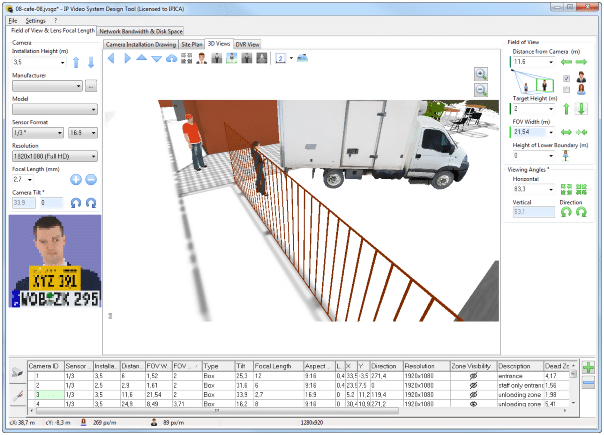One of the most important CCTV Cameras design parameters which are highly underestimated by CCTV design specialists is including high-level details Field of View for each placed CCTV camera. Missing cameras FoV can create critical issues during the installation stage, especially with the lens calibration, camera right sensor format, and the verification of the camera can achieve the intended operational requirements and the pixel density.
It is always not advisable to use CCTV security cameras with fixed focal lengths as they are less expensive and give smaller distortions, but they do not offer flexibility in terms of field of view choices.
CCTV Cameras FOV (Field of View) can be dominated by the width or height of the scene to be monitored. FoV relies on several factors such as the sensor format, the focal length of a lens, and the distance from the objects. Installing multiple CCTV cameras on one building corner and monitoring multiple outdoor areas must include FoV design for each camera.
The first point of difference between security cameras is whether the lens is fine or varifocal:
(1) A fixed or board CCTV camera lens has a position viewing angle. This means that the camera lens cannot be zoomed or adjusted in any way. Fixed lens cameras are generally less expensive so this can be a good option if the layout of an area is unlikely to change (such as a room in a house).
(2) A Vari-focal or manual zoom CCTV camera lens can be adjusted by the CCTV technician, so it focuses on exactly the area that you wish to record. This advantage also means that the viewing angle of the surveillance camera can be tweaked to capture the ideal image plus it has the flexibility to be adjusted later if the area layout or your requirements change.
Key parameters related to the CCTV camera Field of View:
Sensor chip size
CCTV cameras come with a variety of chip sizes such as 1/4 a, 1/3 a, 1/2 ″ and 2/3 a. Different sizes also affect the viewing angle – chip size makes the viewing angle smaller.
Focal length
The focal length is measured in millimeters (mm) and indicates the viewing angle. As you can see above a short focal length (eg 3.6 mm), will give you a wide angle. A longer focal length (eg 12 mm) will give a narrow angle of view.
Depth of field
Depth of field is the distance within which objects in a photograph are in focus. A large depth of field means that almost all objects are in focus while a small depth of field means that only a small portion of the overall field of view is in focus.
A simplified calculation for a 1/3-inch CCTV lens can be made using the following formula:
W (horizontal width) = (distance) * 4.8 mm / (Lens Focal Length)
where 4.8 mm is the horizontal size of a 1/3″ CCTV sensor
Calculating the required lens which can achieve a required FoV using a simple online or card calculator can be non-accurate as most of the time those calculators are missing the defined target height and camera installation height.









